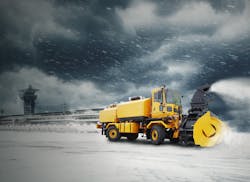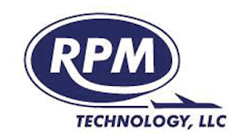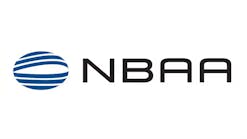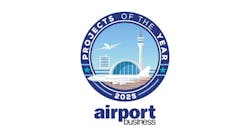Oshkosh Striker Volterra
Oshkosh Corp. is bringing a greener alternative to the airfield with the recent introduction of its Striker Volterra hybrid electric ARFF vehicle.
The unit uses a parallel-electric drivetrain with an electro-mechanical infinitely variable transmission, which allows zero-emissions operation when powered by the integrated onboard batteries. It can be coupled to the internal combustion engine to provide continuous and uninterrupted power to the pumping system or drive system.
“We’re at a point now that the value of this technology and the cost of this technology has now aligned with what the customers expectations are to drive greener initiatives at airports and their ground support and AOA-type vehicles,” said Jack Bermingham, business unit director for Oshkosh Airport Products. “The Striker Volterra has both the cost parody and benefit that’s applicable to this type of niche equipment markets.”
The Striker Volterra features a 13-liter diesel engine with an onboard battery to allow a variety of driving and operational modes to either combine or use the battery or engine exclusively during operations. The unit can drive in full EV mode while the diesel engine still supports pumping operations.
“With the combination of the engine and the battery, you’re actually able to get to the end of the runway quicker than with a conventional diesel engine,” Bermingham said.
The 6x6 chassis includes a 3,170-gallon water tank, 444-gallon foam tank, 2,000 GPM water pump and 550 pound dry chemical powder system.
The Striker Volterra is compliant to NFPA 414 and ICAO standards while being certified to off-highway EPA and EU regulations. It’s available in both the 4x4 and 6x6 chassis platforms.
“The Striker Volterra meets and exceeds all the requirements of the conventional drivetrain,” Bermingham said. “From a firefighting standpoint, you don’t have to change anything. You don’t have less agents or less pumping capabilities or less acceleration performance. You have all the same things that airport firefighters around the globe need to do their job.”
The batteries can be charged by the diesel engine on the vehicle, a regenerative braking system and it can be plugged into a fire station charging system. It can run on zero emissions up to an hour, eliminating idle exhaust while on standby.
The Striker Volterra operates the same as a conventional ARFF unit. The truck manages the energy sources, so no additional training is needed for operation.
“Because it can meet the same requirements as a Striker, any airport that requires this type of product for their commercial or military aircraft service would find it beneficial to them,” he said. “Anyone who wants to support and protect the traveling public and also protect the environment as well.”
Vammas B750 Airport Snow Blower
Fortbrand Services LLC offers a solution for airports looking for a Class VI Snow Blower that meets Buy American provisions.
The Vammas B750 Airport Snow Blower is a high-speed and high-capacity airport snow blower designed to remove piles and windrows of snow from Aircraft Operating Areas including runways, taxiways and ramps. The unit can remove snow at a rate of 7,500 tons per hour while operating at speeds of up to 40 miles per hour, reducing occupancy time on runway and airfield surfaces by snow removal crews.
“Airports are very familiar with the operations and servicing of this type of equipment," said Carlton Braley, senior vice president of sales for Fortbrand Services. "This vehicle was designed for the simplicity for operators and mechanics. Basic training is provided during the delivery and commissioning of each unit.”
The Vammas B750 horsepower and torque comes by utilizing three identical standard and conventional engines instead of specialty engines that are not readily available or are difficult to service. This unit is manufactured in the U.S., provides sufficient capabilities to meet the Class VI specifications and at a very reduced cost due to the three-engine configuration.
“All airports that receive greater than 6-inches of snow annually would benefit from this equipment,” said Andrew Perrone, vice president of airfield maintenance equipment for Fortbrand Services. “Airports utilizing AIP funding would most appreciate that this equipment is tested and certified to meet the performance specifications along with meeting the Buy American provisions. Airports with limited occupancy times on their runways and airfield surfaces would benefit from the performance capabilities of clearing two miles of runways in less than 10-minutes.”
Airports looking at new snowblowers should consider if they’re meeting the expectations of both FAA and the operating airlines during winter operations and if crews are responding to each winter weather event as “expeditiously as possible” until a runway surface condition of “no worse than wet” is attained.
Every airport that receives snow needs at least one snow blower. To calculate the number and capacity of these blowers Braley said the airport must ask several questions including air service business at the airport during winter weather events; the number of aircraft operations during peak periods of each day; when are the most restricted occupancy times during most events; and what is the anticipated snow fall accumulations between occupancy times.
“They should ask each vendor to certify the performance and capacity of their equipment to ensure they are receiving what they are paying for,” Perrone said. “They should ask if the equipment meets all provisions listed within the AIP Guidelines allowing the airport to utilize AIP Funds. The airport should ask for references from other airports who own and operate like equipment from same vendor. What type of operating and maintenance service is provided by the vendor? What are the parts support network?”
RPM Tech AF1 EVO Cold Air Blower
RPM Tech is bringing more power and easier use to the airfield with the third series of the AF1 EVO Cold Air Blower.
The AF1 EVO is used for clearing snow and ice around runway lighting. The burst of air moves the materials away from the lighting without damaging them while performing winter maintenance operations. Airports can also adopt the blowers to remove dust, debris, FOD and other foreign objects on the runway.
“Some airports use it in their conga line,” said Mike Minicucci, senior account manager for RPM Tech. “They will start with the cold air blower right up front and push the snow off the lights and into the runway where the high-speed sweeper or plow is lined up next and they toss it over to the end of the runway. It’s a very efficient machine.”
The third series upgrades include a three-stage centrifugal high-performance blower driven by a diesel engine and provides an air speed of up to 535 miles per hour. The blower module has its own fuel tank and provides up to eight hours of fuel autonomy during operation.
The front spout is no longer in the operator’s view while traveling as it can be stored in the back of the truck. It’s operated via a joystick and touchpad to simplify usage on the airfield. Minicucci said the changes came from airport customer feedback.
“The main feedback was operator comfort because they want their operators to be able to stay in their vehicles longer because in the winter, the snow doesn’t have a set time on when it’s going to fall or how long it’s going to last,” he said. “The better the comfort in the vehicle, the less fatigue for the operator, less danger of accidents and more productivity.”
The AF1 has been produced for nearly 40 years, proving it’s a reliable technology for the industry with upgrades to meet today’s needs. Minicucci said the support is provided with the product.
Operator training for the AF1 focuses mainly on the electronics Minicucci said. It’s a fully computer-based system, where RPM Tech trains them on usage and how to dial in specific parameters for operation.
“New operators coming onto the scene really like technology,” Minicucci said. “They’re all for the touch screens and digital technology, so we’re evolving for that.”
Minicucci said using the AF1 EVO provides operational cost savings by reducing wear on sweeper units. It costs significantly less than a sweeper unit and can be deployed to clear a runway for lighter snowfall.
“It uses ambient air and blows that out onto the snow and runway,” he said. “It doesn’t melt out and create a situation where water is created and ice is formed. It blows it away with the ambient air.”
Schwarze A7 Zephyr
The Schwarze A7 Zephyr is designed to meet the rigorous demand standards of the Department of Defense high speed sweeping requirements for quickly and effectively removing FOD.
The unit is designed to remove both ferrous and non-ferrous debris. Other models are available that can clean in ancillary areas like parking decks and roadways around the airfield.
The A7 Zephyr incorporates four distinct FAA approved methods for FOD removal in one packaged unit:
- Vacuum and brush removal of debris
- Powerful truck mounted magnet to collect ferrous material
- High velocity blast air to push material from surface.
- Liquid removal and pump off (glycol recovery)
Regenerative air technology regenerates the vacuumed air and recirculates it to the pick-up head for surface scouring of pavement cracks and joints. This provides superior sweeping with single pass performance resulting in better efficiency.
“This provides better FOD containment to meet FAA guidelines,” said Brian Giles, product manager, Schwarze Industries. “It also provides higher utilization when equipped with additional features like catch basin hoses, side air blast for blowing grass clippings and glycol or other liquid recovery.”
Small airports, including private fields generally purchase the Schwarze A4 Storm. Larger airports purchase either the A7 Tornado or A7 Zephyr depending on the applications required.
“Schwarze provides a training academy in Huntsville, Alabama for mechanics,” Giles said. “Schwarze products are supported by a national dealer network. Local dealers are factory trained and can provide local operator and mechanic training. Operators only need one week of training.”
MB4 High Speed Runway Snowblower
The MB4 high speed runway snowblower functions at a high capacity with the ability to move 7,500 tons of snow per hour. When used simultaneously with other plow and broom equipment, the MB4’s high-speed capability enables it to keep up with other equipment, offering increased runway clearing efficiencies.
The MB4 features separate drive and auxiliary blower head engines and has dual 125-gallon fuel tanks to power up to 12 hours of operation. The 500 hp chassis drive engine is an electronic turbocharged diesel engine and is T4F EPA emission certified. Both engine enclosures on the MB4 feature full length, full height butterfly side covers that rotate upward, exposing the entire engine compartment for unimpeded maintenance access.
“In general, most airports have a limited snow clearing time; therefore, the equipment must be able to complete the job during that window. When various types of clearing equipment are used, the blower is generally in the last position behind the plows and brooms,” said Alan Luke, sales, MB Airport Maintenance Products. “The snow blowers must be able to move the snow pushed by plows and brooms at the same speed. The MB4 has this capability.”
Luke said the MB4 is simple to operate. The two-man cab has integrated microprocessor CAN bus controls that allow for efficient communication between the electronic control units (ECUs) throughout the vehicle, with a single point of entry for system diagnostics, data logging and configuration. MB designed it to be uncomplicated and straightforward to operate, requiring minimal training for equipment operators.
“The operator simply needs to control the direction of the discharge and the control system adjusts the ribbon speed to outrun the vehicle speed,” he said. “If necessary, the ribbon speed is adjustable for wind conditions that may cause operator visibility issues.”
The MB4 uses a butterfly-style hood enclosures enabling easy access for both the auxiliary and chassis engines. Engine maintenance is standard and uncomplicated for airport equipment mechanics and maintenance technicians.
“MB prides itself on service and technical support for all its custom-built equipment,” Luke Said. “Should there be an issue with an MB4 or any piece of MB equipment, MB’s technical team will work to ensure that its equipment is back up and fully operational as soon as possible.”
The MB4 is applicable to all size airports. It’s especially geared for airports requiring a high-speed blower to keep pace with other snow removal equipment. The unit has the power and capacity to blow all the snow pushed by the other equipment up and over the runway lights, while keeping up with the other equipment.
The Eagle CLAAS
Team Eagle offers airports a high-end snow removal vehicle with the ability for year-round usage.
The Eagle CLAAS removes snow and can be used as a ramp plow and cleaner. Equipped with a 520HP Mercedes engine, it converts into a heavy-duty turf and agriculture product to handle other airfield maintenance tasks, such as grass cutting and pavement sweeping during warmer months.
“Instead of purchasing one piece of equipment just dedicated to one thing, this machine can quickly change between attachments and save the airport a large amount of capital,” said Ben McKeown, commercial business manager for Team Eagle. “If you take a traditional piece of equipment and if you take the lifecycle into account, it can cost $100 to $200 per hour of its lifespan. We’ve done costs analysis with some major airports in the U.S. and Canada and the Eagle CLAAS cost is between $20 and $50 per hour.”
All of the hydraulics use Stucchi quick connects to speed up the conversion of the unit between uses. Hydraulic controls are located on the fenders of the unit, so crews don’t have to go into the cab of the CLAAS to control the system while installing attachments. The cab is also designed to spin 180 degrees so an operator can look down at hitching while it’s taking place.
“There is no other product on the market that you can use to blow snow, sweep and push a plow and cut grass in the summer,” McKeown said. “If you’re going to spec out a 4,000 to 5,000 ton per hour snowblower that can also cut grass, this is the only option you’re going to find.”
McKeown said the Great Sudbury Airport used to use three operators on three pieces of equipment to clean its aprons in three hours. The airport purchased a CLAAS with a 36-foot ramp plow and snow blower and now one operator can clean them in less than an hour.
Using one piece of equipment for multiple duties cuts down on training time as well. Instead of learning about three different machines, operators and mechanics only need to train on the one unit.
The CLAAS eliminates the need for storage of dozens of snow removal units in the warmer months for larger airports as they’re continuously used for different operations throughout the year. Smaller airports save on capital investments by cutting down on the amount of equipment they’re purchasing.
“If they’re looking to buy a snow blower, they can buy the CLAAS and then they don’t need to purchase a tractor for the summer,” McKeown said. “If an airport really needs a blower and a loader to remove snow on the apron, but they have to pick only one because of the cost, they can just go with the CLAAS and purchase the different attachment the next year.”
McKeown said airports need to think past just snow removal when considering the CLAAS and if it’s the best investment for them.
“You need to look at your future capital acquisition list. The CLAAS might be more than a standard snow blower unit, but next year it could save $300,000 on buying a tractor and the year after when you need to buy a ramp plow.”
Leonardo SnowBOSS
The Leonardo SnowBOSS is a Runway Incursion Warning System (RIWS) module, a part of the AeroBOSS Airport Safety and Operations Suite, is a solution geared towards safety and fleet management. The hardware and software is deployed in airport ground vehicles, which allows staff to track movements of the vehicles while also giving operators an embedded RIWS, which is fully compliant with the FAA Advisory Circular (150/5210-25A) for RIWS.“It allows the snow removal team and airport supervisors to see in real time where the fleet is, to see in real time where aircraft are located on the surface and in the air, and gives them situational awareness,” said Carlos Nevarez product manager for the AeroBOSS suite. “They’re able to coordinate snow removal operations in all areas of the airport – not just the movement area, during all types of winter weather and during irregular operations (IROPS).”
The units are mounted inside the cab of ground and snow removal vehicles track the vehicle location. The SnowBOSS RIWS functionality warns operators if they’re going to enter a runway safety area before entry is made. If they’re not cleared to enter the runway safety area, the operator has sufficient time to stop or change direction before creating a Vehicle Pedestrian Driver (VPD) incursion.
“When a snow removal team is out there, often times it’s not the best visibility,” Nevarez said. “By having that RIWS component, it’s improving the safety of that operation in relation to the runway safety areas or any other areas the airport flags as critical spaces.”
The SnowBOSS allows snow removal team leads to coordinate where the crew goes to work around traffic flow of aircraft. This reduces idle time and reduces costs to clear the airfield in a snow event.
“There are independent fleet management systems that can be deployed on equipment like this, but what we’ve learned is the frequency of the updates of the vehicle tracking is nowhere near our sub second update rate or accuracy,” Nevarez said. “They’re typically five to 10 second latency rate, which is effective for use inside an airport.”
The system is designed to be intuitive. It only takes about 15 minutes to train a snow removal equipment operator on how to use it. Supervisor training takes about one hour to educate them on all the features available to them.
Nevarez said the SnowBOSS meets the standard for FAA Airport Improvement Program funding.
“Ask yourself if you’ve had issues with my team causing runway incursions when operating in reduced visibility,” he said. “If the answer is yes, then the airport should consider this type of solution in order to improve safety in the movement area.”








